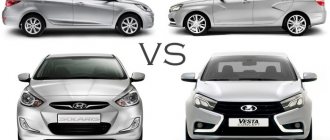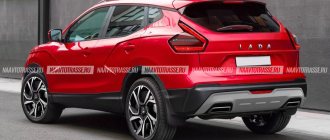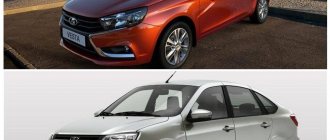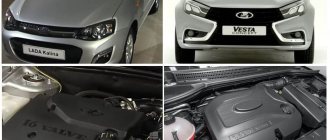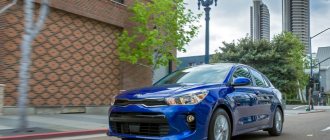The VAZ 2107 model, also known in our country as the “seven”, was supplied abroad under the names Lada 1500, Nova or Riva. The basis for this unit was a small Italian sedan from Fiat. This people's car was produced by different factories, and its production continued until 2014.
Interior and appearance of the "Seven"
Compared to its predecessors, the VAZ 2107 received an improved internal and external design. The “Seven” can be recognized by its large chrome radiator grille, the original structure of the rear lights, and plastic chrome bumpers that replaced expensive aluminum ones.
The seats in the car were complemented by comfortable integrated headrests. In some copies of the “seven” you can find a ceiling with rigidly formed lining. The 2107 differed from previous VAZ models by a modernized instrument panel, which featured a speedometer designed for 180 kilometers per hour, as well as an oil pressure sensor. Another innovation in the VAZ 2107 interior was air deflectors.
"Seven" of the last years of production
The VAZ 2107, produced in the last years of the model's production, was unified in order to minimize the selling price. Many classic elements of the seven were made from cheap materials. Thus, ashtrays disappeared on the rear doors, and rubberized door handles began to be made of hard plastic.
The VAZ 2109, also known as Sputnik or Lada Samara, is a five-door hatchback traditionally equipped with front-wheel drive. This car, unlike the “seven”, was considered a more respectable model, intended for a family man. The appearance of the 2109 has become less expressive thanks to the appearance of a fifth door and simple body lines.
The basic version 2109 was equipped with a 1.3-liter carburetor engine. Even with the interior fully loaded, this car could reach speeds of up to 155 kilometers per hour. More modern “nines”, the production of which ended in 2011, are equipped with a 1.5-liter engine.
Mostly on sale are “nines” with a five-speed manual gearbox, but there were also examples in production equipped with a four-speed gearbox. The car is equipped with a reliable steering mechanism that is sensitive to the driver's movements.
At first glance, the interior of the VAZ 2109 is quite practical, but it is not devoid of comfort. The front seats are equipped with headrests, and the seat belts can be adjusted in height. Compared to previous VAZ models, including the Seven, the 2109 can please you with an improved interior: high-quality fabric upholstery of seats and doors.
The choice between VAZ 2107 and 2109 depends on the desires of the buyer, because a five-door hatchback and a four-door sedan are different cars. The advantages of these models are low-cost maintenance and repairs, as well as the ability to create a unique car through tuning.
VAZ 2107
The Seven is a classic Zhiguli, that is, a typical representative of the VAZ family of 5-seater rear-wheel drive sedans, originating from the Fiat 124 . It is the result of the modernization of the five - VAZ 2105. The car was produced from 1982 to 2012, and the last year was produced exclusively at the Izhevsk Automobile Plant. At one time it was one of the most popular domestic passenger cars. , more than 3 million copies were produced .
Most of the cars were equipped with a 1.5-liter gasoline carburetor engine with a power of 77 hp, but there were also modifications with a 1.3-liter engine from the VAZ 2105. At a later time, 2107s were produced with a 1.6-liter engine with a power of 73 hp .With. with distributed injection. The gearbox is manual 5-speed.
The car is well adapted (compared to other domestic cars) to the conditions of Russian roads, and has a fairly stiff suspension. The wheelbase is 2.4 m , ground clearance is 175 mm.
The maximum speed is 150 km/h, acceleration to 100 km/h is carried out in 17 seconds . Average fuel consumption is from 8 to 10 liters per 100 km. Tank volume 39 liters .
VAZ 2109
Nine, also known as Samara, is a front-wheel drive passenger car with a hatchback body developed by the Volga Automobile Plant, where it was mass-produced from 1987 to 2004. From 2005 to 2011, cars were produced in Ukraine at the ZAZ plant using the final assembly method. the nickname “Chisel” for its characteristic wedge-shaped body.
In fact, 2109 is a 5-door modification in the family of models in the Lada Sputnik family of models, so the appearance of the nine is very reminiscent of the VAZ-2108. But unlike the eight, it was initially positioned as a more solid car for a family man.
Initially, the Chisels were equipped with carburetor gasoline engines of 1.1, 1.3 and 1.5 liters with a power of 54 hp, 64 hp. and 70 hp, respectively.
Since 1994, cars began to be equipped with 1.5-liter injection engines producing 72 hp. The gearbox is manual 5-speed. The maximum speed is 155 km/h, while acceleration to 100 km/h is carried out in 14 seconds. Average fuel consumption ranges from 6 to 9 liters per 100 km.
The wheelbase of the VAZ 2109 is 2.4 m , ground clearance is 165 mm . Tank volume 43 liters .
Where to choose
Each buyer must decide for himself which car is best for him. This depends on a number of factors, so you need to build on not one, but several of the most important criteria.
Summing up the comparison of the VAZ-2109 and VAZ-2114, we can draw the following conclusions:
- the fourteenth model is an improvement on the “nine”, but in no way a transition to a completely new car or a serious revolution in the field of the domestic automotive industry;
- The VAZ-2114 received a modified front part of the body, which became more interesting and attractive, but lost the reliability of the bumper;
- the fourteenth VAZ has a new dashboard, which brings the car closer to the European level in terms of comfort and simply in appearance;
- cars were assembled at different enterprises, which is why even identical cars sometimes turn out to be of unequal quality;
- The VAZ-2114 was made with the goal of getting closer to European quality standards and giving the car a laconic, interesting and dynamic appearance;
- The VAZ-2109 remains one of the most reliable domestic cars, which continue to be in great demand.
We can say with almost 100% confidence that the release of 2114 did not fully meet the automaker’s expectations. AvtoVAZ wanted to make this car a worthy replacement for the legendary “Nine”, which would satisfy the needs of modern consumers and be able to compete with imported cars. The result was almost the same VAZ-2109, but with a changed appearance and a modernized interior. The essence remains the same. Especially until the manufacturer decided to add a 16-valve engine to the line.
Differences
There are two main differences between the cars. The first is the body type and, as a result, the appearance. If the 2107 is a sedan, then the 2109 is a typical hatchback . Despite the initially larger trunk volume of the seven, the nine has the feature of being able to recline the backs of the rear seats, thereby significantly increasing cargo capacity. However, it will have to carry fewer passengers.
The second difference is the drive. If the VAZ 2107 is rear-wheel drive, then the VAZ 2109 is a front-wheel drive car. Based on this, the control styles of the two cars are different. When entering a turn on a seven, you need to slow down for greater stability, and on a nine, on the contrary, you need to accelerate a little.
Since both cars have a motor in the front, their front axles are more loaded. Due to this, the front-wheel drive 2109 has better traction during acceleration than the rear-wheel drive 2107, provided that the 7 was not specially loaded by placing something heavy in the trunk.
One brand - different approach to design: who is sharper on the move
“Seven” is a direct successor to the Fiat 124, which was developed back in the 1960s of the last century. Compared to modern cars, it has neither a smooth ride, nor steering sharpness, nor composure. At high speeds the car floats, so it feels completely uncomfortable on the highway. But the cross-country ability due to the ground clearance of 170 mm is excellent.
And because of the rear-wheel drive platform, the car can be turned from a boring family sedan into a drift car for winter rides. True, for these purposes the suspension will have to be modified.
The “Nine”, although it came off the production line in the same decade as the “Seven”, has a more modern design. Thanks to the Porsche and ItalDesign specialists who had a hand in creating the Samara. The car received a new front-wheel drive platform and suspension design, so it handles much sharper than the “Seven” and seems more collected and obedient on the move. But the ground clearance here is 1 cm less, and, accordingly, the cross-country ability is worse.
At the front, the “nine” has an independent MacPherson strut, and the “seven” has double wishbones. The designs are simple, reliable and rarely present “surprises”. Most often, ball joints and wheel bearings fail in both cars. The cost of parts is from 500 to 1,000 rubles, replacement will cost about the same. The Sema's rear brake cylinders also become sour - we recommend changing them as often as the pads.
Also read: “Lada Kalina II” or “Lada Priora I”: which is better and does it make sense to buy
What's better
We will not consider the appearance, since everyone has different tastes and preferences: some people prefer the chisel-shaped shape, while others, on the contrary, prefer the classic look. The main arguments in favor of the seven are lower cost, greater maintainability, and cheaper spare parts. In addition, the classic has a quieter interior and a slightly larger capacity. The car is better adapted to Russian roads and has greater ground clearance. At the same time, the 2109 is favored by its engine efficiency, more advanced suspension, easier handling, and greater driver comfort.
For trips in urban conditions, for example to work or school, the nine is more preferable, as it can accelerate faster and has lower fuel consumption at a higher average speed. It is also more suitable for traveling on highways due to the fact that it does not throw or sway at high speed.
There is another argument in favor of the Classics. One of the current trends is the purchase of cars that are “not a pity” for entertainment or tuning. If the car is purchased for drifting, then rear-wheel drive will play a decisive role in the choice between 2107/2106 or 2109, and the nine will not be able to compete here.
2109 2000 and you know, after driving the nine and comparing with spare parts, I will definitely say my opinion, all the classics have a bucket of bolts, there are a lot more problems with them!! The number nine also has its own problems that can be corrected in the amount of about 20 thousand. . but also this correction of these shortcomings gives an awesome plus in the cross-country ability and controllability of the car! After all the modifications, the Nine becomes a good car and a little capricious, not like the VAZ 2106, once you give good pussies over the bumps and the fucker comes to everything! So my opinion is that I’d rather take a jacked-up nine and drive it calmly than a new 2106 or 2107... a bucket, that’s my opinion!
Where to choose
Each buyer must decide for himself which car is best for him. This depends on a number of factors, so you need to build on not one, but several of the most important criteria.
Summing up the comparison of the VAZ-2109 and VAZ-2114, we can draw the following conclusions:
- the fourteenth model is an improvement on the “nine”, but in no way a transition to a completely new car or a serious revolution in the field of the domestic automotive industry;
- The VAZ-2114 received a modified front part of the body, which became more interesting and attractive, but lost the reliability of the bumper;
- the fourteenth VAZ has a new dashboard, which brings the car closer to the European level in terms of comfort and simply in appearance;
- cars were assembled at different enterprises, which is why even identical cars sometimes turn out to be of unequal quality;
- The VAZ-2114 was made with the goal of getting closer to European quality standards and giving the car a laconic, interesting and dynamic appearance;
- The VAZ-2109 remains one of the most reliable domestic cars, which continue to be in great demand.
We can say with almost 100% confidence that the release of 2114 did not fully meet the automaker’s expectations. AvtoVAZ wanted to make this car a worthy replacement for the legendary “Nine”, which would satisfy the needs of modern consumers and be able to compete with imported cars. The result was almost the same VAZ-2109, but with a changed appearance and a modernized interior. The essence remains the same. Especially until the manufacturer decided to add a 16-valve engine to the line.
If you want a “nine” with a more attractive design, excellent tuning capabilities and electric windows, but are willing to pay a little more, you should definitely take the VAZ-2114. Only experienced motorists strongly recommend in this case to take the version only with a new engine. In combination with eight-valve engines, the fourteenth model loses a number of its advantages. For people who need a structurally simple, reliable and durable car, although deprived of some of the charms of European-style cars, the “nine” is perfect. In addition, now there are many ways to transform the car yourself, install the same electric windows with your own hands, change the appearance and add various types of equipment to the interior. The VAZ-2109 is cheaper, but in fact it is not much inferior to its successor.
Make the decision yourself. Much depends on the condition in which you find the car. In this regard, we will add that it is better to take a “nine” in excellent condition than to buy a VAZ-2114 for the same money with obvious problems with the body or engine.
